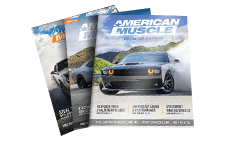Challenger Factory Brake System
Aside from the Brembo setups that may or may not be ordered with a Challenger, there are some issues when it comes to the factory setups. Luckily, all third gen Challengers have discs all around so no major conversions will need to be made.
Even on V8 models, factory equipment will only have two-piston calipers matched with 13” rotors at most. For street driving in a stock application, this works perfectly. After making modifications or during hard driving, the weight and momentum of the car can really start to overpower the stock system.
Big Brakes and Why You Need Them
The idea of a big brake kit is to increase stopping power. This is typically one in two ways: by increasing the size of the brake rotor and/or the number of pistons in the calipers. More pistons increase the amount of pressure applied to the pads, and bigger rotors increase the contact surface making for more friction. Because of this, big brake kits improve responsiveness in the braking system.
Why do you need this? Improving braking is beneficial for safety reasons and can even improve track times. They improve control over the vehicle and allow for increased driving precision. Deceleration will be increased from a sluggish halt that will make any jaw clench to a sensation of nearly being sent through the windshield.
It may take a bit of getting used to and can be unsettling at first. However, once you get the feel down, you will be able to approach corners at greater speeds, increase 0-60-0 times and push through the quarter mile with confidence.
Why Your Wheel Size Matters
When making this upgrade you’ll need to take wheel sizes into consideration. Big brake kits feature larger rotors which may not fit within the factory wheel. It’s important to double check the specs listed in the kit to ensure it will fit your vehicle. Challengers with larger aftermarket rims can fit larger brakes, but you’ll still want to double check the specifications of the particular big brake kit you are interested in to make sure you’re within range.
Just because a brake kit may fit your specific vehicle doesn’t mean the wheels can accommodate them either. For those with factory wheels on their Challenger, refer to the list below as these are the factory rim sizes for the appropriate models.
| Challenger Submodel | Wheel Diameter |
|---|---|
| 2008-2010 SE | 17" |
| 2008-2010 RT | 18" |
| 2008-2010 SRT8 | 20" |
| 2011-2014 SXT | 18" |
| 2011-2014 RT | 18" |
| 2011-2014 SRT8 | 20" |
| 2015-Current SE | 18" |
| 2015-Current RT | 20" |
| 2015-Current SRT8 | 20" |
| 2015-Current Hellcat | 20" |
Challenger Rotor Styles
Aside from caliper piston count and rotor sizes, there are some other features that help with braking. Rotors can come with different features to help with brake cooling, corrosion, and pad wear.
For cooling purposes, you will find rotors that are drilled, slotted, dimpled or a combination. It’s important to know rotors with these features are directional and have a specific configuration in which they should be oriented on the wheels.
Protection against corrosion goes hand in hand with pad wear. Corroded brake parts cannot move as freely.
When these parts bind up or are deprived of making proper contact, pads can wear in an odd pattern, which will decrease braking power rapidly. Steady brake wear prolongs brake life, which is why big brake kits will come with various types of coatings on the rotors.
Challenger Pad Types
Just like rotors, brake pads can consist of added materials to help with corrosion and wear. Keep in mind many pads are developed for an intended purpose. While shopping for big brake kits it’s important to get as much information on the pads being used as possible.
Pads intended for track use are not good options on the street and the same vice versa. Those with multi-purpose vehicles can be equipped with pads to suit their needs rather than being forced to choose between the two.
Installation
Big brake kits are vehicle specific. This means no modifications will need to be made to the Challenger in order to be installed; with the exception of wheel sizes of course. The process will require either a helping hand or the use of specialty tools for bleeding the brakes.
The process of installing these kits is very similar to a basic brake service job and only requires a few extra steps. The overall time to do this job is subjected to experience level but even for a novice, it shouldn’t take more than a few hours to hammer through.
Fitment Includes:
- 2008, 2009, 2010, 2011, 2012, 2013, 2014, 2015, 2016, 2017, 2018, 2019, 2020, 2021, 2022 and 2023 Dodge Challenger
- SRT8, R/T, SE, R/T Classic, SXT, SXT Plus, Rallye Redline, R/T Plus, Scat Pack, SRT 392, SRT Hellcat, 392 Hemi Scat Pack Shaker, R/T Plus Shaker, R/T Shaker, GT, T/A, SRT Demon
- 3.5L V6, 3.6L Pentastar V6, 5.7L Hemi V8 6.1L Hemi V8, 6.2L Hemi V8, 6.4L Hemi V8
*Please see product pages for any exceptions.
